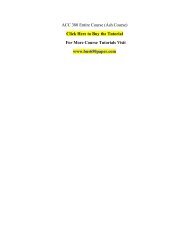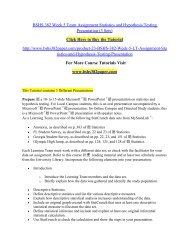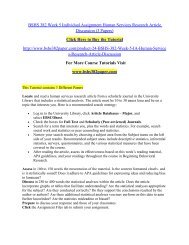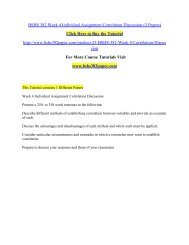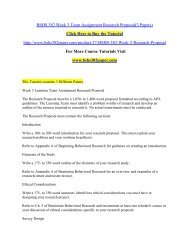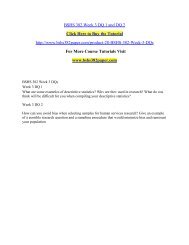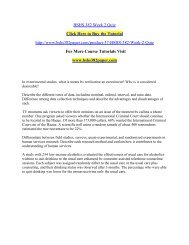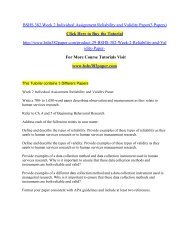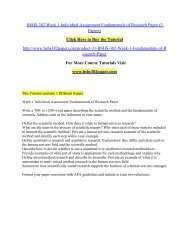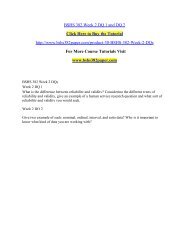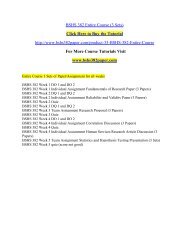BSHS 382 Week 3 Quiz/ bshs382paperdotcom
For More Course Tutorials Visit www.bshs382paper.com 1. Follow the steps to compute the variance and standard deviation for the following population. 49 51 53 55 57 59 61 2. For a sample of 289 female heights, the mean was 65.3 inches and the standard deviation was 2.8 inches. The shortest person in this sample had of 56 inches. a. Find the z-score for the height of 56 inches. b. What does the negative sign for the z-score represent? c. Is this observation a potential outlier according to the three standard deviation distance criterion? Explain. 3. A company decides to investigate the amount of sick leave taken by its employees. A sample of seven employees yields the following numbers of days of sick leave taken in the past year. 1 1 3 0 1 6 2 Use this information to answer parts a through c. 4. What is the effect of the outlier? 5. A survey asked 6189 random adults the question “How many children have you ever had?” Use the results shown below to answer the following questions. # no of children 0 1 2 3 4 5 6 7 n 1851 869 1462 945 494 281 153 93 a. Find the standard error of the sample mean of the random sample of 6189 adults. b. Construct a 95% confidence interval for the population mean µ. Can it be concluded that the population mean is less than 2.0? c. On what assumptions is the analysis in part (b) based? Is the assumption of randomization valid? Is the assumption that the population distribution is approximately normal a valid assumption? 6. A survey asked the question “What do you think is the ideal number of children for a family to have?” The 473 females who responded had a median of 2, mean of 3.13, and standard deviation of 1.48. Answer parts a-d. a. What is the point estimate of the population mean? b. Find the standard error of the sample mean. c. The 95% confidence interval is (3,3.26). Interpret. d. Is it plausible that the population mean µ = 2?
For More Course Tutorials Visit
www.bshs382paper.com
1. Follow the steps to compute the variance and standard deviation for the following population.
49 51 53 55 57 59 61
2. For a sample of 289 female heights, the mean was 65.3 inches and the standard deviation was 2.8 inches. The shortest person in this sample had of 56 inches.
a. Find the z-score for the height of 56 inches.
b. What does the negative sign for the z-score represent?
c. Is this observation a potential outlier according to the three standard deviation distance criterion? Explain.
3. A company decides to investigate the amount of sick leave taken by its employees. A sample of seven employees yields the following numbers of days of sick leave taken in the past year.
1 1 3 0 1 6 2
Use this information to answer parts a through c.
4. What is the effect of the outlier?
5. A survey asked 6189 random adults the question “How many children have you ever had?” Use the results shown below to answer the following questions.
# no of children 0 1 2 3 4 5 6 7
n 1851 869 1462 945 494 281 153 93
a. Find the standard error of the sample mean of the random sample of 6189 adults.
b. Construct a 95% confidence interval for the population mean µ.
Can it be concluded that the population mean is less than 2.0?
c. On what assumptions is the analysis in part (b) based?
Is the assumption of randomization valid?
Is the assumption that the population distribution is approximately normal a valid assumption?
6. A survey asked the question “What do you think is the ideal number of children for a family to have?” The 473 females who responded had a median of 2, mean of 3.13, and standard deviation of 1.48. Answer parts a-d.
a. What is the point estimate of the population mean?
b. Find the standard error of the sample mean.
c. The 95% confidence interval is (3,3.26). Interpret.
d. Is it plausible that the population mean µ = 2?
- No tags were found...
Create successful ePaper yourself
Turn your PDF publications into a flip-book with our unique Google optimized e-Paper software.
<strong>BSHS</strong> <strong>382</strong> <strong>Week</strong> 3 <strong>Quiz</strong><br />
Click Here to Buy the Tutorial<br />
http://www.bshs<strong>382</strong>paper.com/product-36-<strong>BSHS</strong>-<strong>382</strong>-<strong>Week</strong>-3-<strong>Quiz</strong><br />
For More Course Tutorials Visit<br />
www.bshs<strong>382</strong>paper.com<br />
1. Follow the steps to compute the variance and standard deviation for the following<br />
population.<br />
49 51 53 55 57 59 61<br />
2. For a sample of 289 female heights, the mean was 65.3 inches and the standard deviation<br />
was 2.8 inches. The shortest person in this sample had of 56 inches.<br />
a. Find the z-score for the height of 56 inches.<br />
b. What does the negative sign for the z-score represent?<br />
c. Is this observation a potential outlier according to the three standard deviation distance<br />
criterion? Explain.<br />
3. A company decides to investigate the amount of sick leave taken by its employees. A<br />
sample of seven employees yields the following numbers of days of sick leave taken in the past<br />
year.<br />
1 1 3 0 1 6 2<br />
Use this information to answer parts a through c.<br />
4. What is the effect of the outlier?<br />
5. A survey asked 6189 random adults the question “How many children have you ever<br />
had?” Use the results shown below to answer the following questions.<br />
# no of<br />
children 0 1 2 3 4 5 6 7<br />
n 1851 869 1462 945 494 281 153 93<br />
a. Find the standard error of the sample mean of the random sample of 6189 adults.<br />
b. Construct a 95% confidence interval for the population mean µ.<br />
Can it be concluded that the population mean is less than 2.0?<br />
c. On what assumptions is the analysis in part (b) based?
Is the assumption of randomization valid?<br />
Is the assumption that the population distribution is approximately normal a valid assumption?<br />
6. A survey asked the question “What do you think is the ideal number of children for a<br />
family to have?” The 473 females who responded had a median of 2, mean of 3.13, and standard<br />
deviation of 1.48. Answer parts a-d.<br />
a. What is the point estimate of the population mean?<br />
b. Find the standard error of the sample mean.<br />
c. The 95% confidence interval is (3,3.26). Interpret.<br />
d. Is it plausible that the population mean µ = 2?



